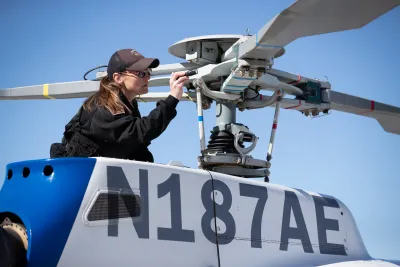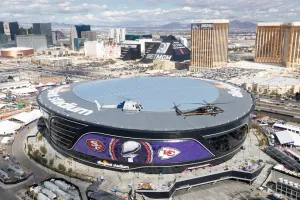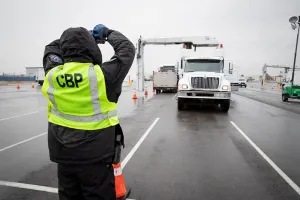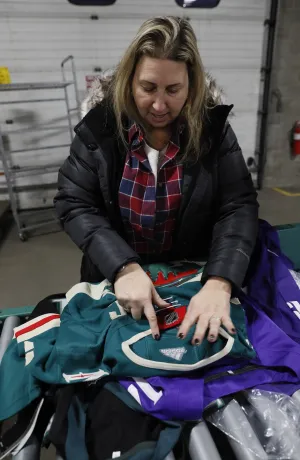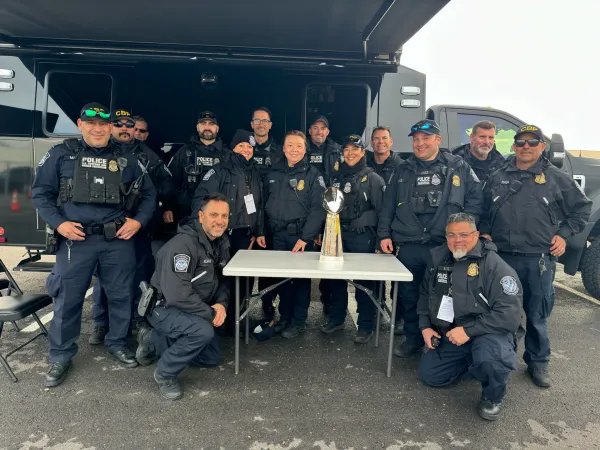CBP brought teams from each uniformed component to ensure the Super Bowl was safe and secure
Astrid Gilbert’s job was defense on Super Bowl Sunday. But she wasn’t part of the San Francisco 49ers or the Kansas City Chiefs at the game played in Las Vegas; she was a U.S. Customs and Border Protection Air and Marine Operations pilot.
“I manned the aircraft that was in charge of aerial surveillance and reconnaissance,” said Gilbert, who normally flies out of Yuma, Arizona. She, along with a camera operator in the seat next to her, provided a video downlink to CBP forces and other federal, state and local law enforcement on the ground to keep an eye out for crowd control, traffic incidents, and even potential terrorist attacks. “We provided them real-time updates they could physically see with their own eyes.”
Just like the teams who made it to the big game, she didn’t come with just one other person. A group of CBP all-stars in their own right wearing green, blue, and tan uniforms and civilian clothes representing Border Patrol, Field Operations, and Air and Marine Operations – a team of teams – were prepared for anything.
Why does CBP bring such a diverse group to high-profile events of national security interest such as the Super Bowl? Because the agency is the only law enforcement group in the world with its myriad of resources and capabilities which can deploy 365 days a year, not just Super Bowl Sunday.
“Every day is game day on the front line of protecting America,” said Cheryl Davies, the director of field operations for the massive Los Angeles office and the lead for CBP’s all-around efforts at the Super Bowl this year. “Our border security mission is absolutely vital to national security. And the same goes for this year’s Super Bowl.”
Davies was in charge of nearly 150 CBP people specifically dedicated to the security of the game from the agency’s major components.
The tens of thousands of fans at the game – as well as the millions watching on television around the world – might not have realized the time and effort CBP put in far away from the field.
“We worked behind the scenes with our local, state, and federal law enforcement partners to ensure a safe and secure event,” Davies said.
CBP’s Senior Official Performing the Duties of the Commissioner Troy A. Miller visited the group of Air and Marine agents, CBP officers, Border Patrol agents and civilian workers at the various areas CBP worked, such as the X-ray inspection areas, the airfield where the CBP helicopters flew from, and the points where merchandise was inspected for any intellectual property rights violations.
“Men and women of CBP are here in Las Vegas alongside our law enforcement partners to support security operations for Super Bowl 58,” Miller said. “CBP has a longstanding partnership with the NFL, and we are proud to be here supporting this true team of teams, ensuring the safety and security of this … event, and of course, the big game. CBP is our nation’s front line protecting the American people, safeguarding our borders and enhancing our economic prosperity.”
As mentioned earlier, part of that work included the eyes in the skies from CBP’s Air and Marine Operations helicopters flying the perimeter of the stadium area.
“Air and Marine’s role is to provide security, providing a link between the ground units and the Federal Aviation Administration’s temporary flight restriction over the Super Bowl, as well as local law enforcement and even the U.S. military providing security,” said Douglas Murray, director of the Air and Marine branch out of Yuma, Arizona, and in charge overall of flight operations at the Super Bowl.
He added what Air and Marine did at the game was similar to what they do every day along the border. “We use our infrared electrical optical cameras on our helicopters to support local and federal law enforcement in the border mission,” Murray said.
And Murray was proud of how his men and women adapted and performed at America’s biggest game.
“It was exciting to be part of this,” he said.
Another key aspect of CBP’s efforts at the Super Bowl was the use of nonintrusive inspection equipment – trucks with powerful X-ray machines and skilled operators that detect anything in a cargo shipment. Normally used at a port of entry, CBP deployed the equipment to scan every single food, beverage and merchandise carrier that came into the Super Bowl stadium area.
“These trucks enable our CBP officers to examine cargo conveyances, such as sea containers, rail cars and commercial trucks, as well as privately owned vehicles, for the presence of contraband without having to physically open or unload that actual container,” said Africa Bell, the Los Angeles/Long Beach port director who was in charge of CBP’s X-ray scanning efforts in Las Vegas. She said this technology helps CBP cut down the amount of time to examine the contents of a shipment or vehicle to just a minute or so – a priority in the fast-paced environment of a Super Bowl supplier. “With the number of private and commercial vehicles that entered the venue, we would have had to push the Super Bowl to a later date if we had to physically unload each delivery vehicle to ensure they were safe.”
X-ray technology is able to “see” through six inches of steel and give the operators in real time a clear picture of the smallest anomalies inside a container – whether that’s weapons or drugs or anything else being illegally smuggled in, giving the operators on the ground a force multiplier to increase their capabilities. But while the technology is cutting edge, Bell pointed out it was a team of highly professional individuals who know what to look for from the images the machines give them.
“We deployed a good group of CBP officers who have experience using the technology and with interpreting the images they’re seeing,” she said, adding it’s a skill on display every day in their border security mission. “The CBP officers who operate these machines are excellent at what they do.”
Bell also emphasized this is what the men and women of CBP do every day.
“This technology allows us to screen high-risk containers coming in to ensure the safety and security of our nation,” she said. “We are the first line of that defense and having this technology supports our mission to safeguard our nation and the American people. The same technology we use to keep our borders safe was used to keep everyone safe at the Super Bowl.”
An even closer secure look is given to some merchandise that enters the game area. CBP’s intellectual property rights specialists are highly trained to identify counterfeits to ensure the fakes of these valued items aren’t part of a trick play by the criminals.
“CBP is committed to ensuring counterfeits don’t reach the American consumer,” said Elva Muneton, the assistant director of field operations in Los Angeles and overseeing CBP’s intellectual property rights and trade issues at this year’s game. “The Super Bowl is the perfect opportunity for counterfeiters to try to flood the market.”
Muneton emphasized that counterfeit items are NOT a victimless crime. Besides the health and safety risks a fake piece of merchandise can pose to the public most people don’t even know about, criminal organizations use the profits from counterfeit merchandise – estimated to be about $1 trillion each year to fund other illicit activities such as drug smuggling and human trafficking. In addition, those criminal organizations can steal financial information from unsuspecting customers and take money out of their accounts. That’s why CBP’s efforts to stop counterfeits continues every day, whether it’s the day of an important game or just a typical day.
“Intellectual property rights and enforcing the laws are priorities for CBP,” Muneton said. “Unfortunately, big events such as the Super Bowl give criminal organizations an opportunity to flood the event with counterfeits, generate revenue and take advantage of the thousands of fans to make their illicit profits. However, CBP personnel were there to address it.”
She also credited a good partnership with the trademark holders who show CBP’s specialists what to look for – a misplaced stitch on the collar a jersey, the holographic logo that doesn’t reflect and shine quite right, the wrong team for a Super Bowl ring.
“The trademark owners will come out and really take the time to train our officers and import specialists to make sure they have the latest technology and information on how the genuine product is produced,” Muneton said. This partnership helps build up the skill sets of some already highly trained and qualified CBP employees. “So, when CBP personnel see these products enter the commerce of the U.S., they’re able to identify them and look for those anomalies in that product.”
The large volume of commerce that comes in through Los Angeles by sea, land, and air means Muneton’s personnel who were at the Super Bowl got plenty of practice for the big game of their own: looking for intellectual property rights violations.
“Our officers get the training to build their knowledge base and look for those counterfeit products during their daily exams,” she said.
Davies added that personnel deployed to support Super Bowl operations weren’t just veterans of the agency’s operations; many were also veterans of past Super Bowls where CBP played a major role in security. And CBP offices in the area are used to providing security at many high-profile events, such as the Rose Bowl in Southern California and Formula One races in Las Vegas. She pointed out that her office hosted the Super Bowl just a couple of years ago when it was played in Los Angeles. And they’re already preparing for next year’s game in New Orleans.
“It’s years of planning for an event like this,” she said. “The team that is hosting next year’s Super Bowl shadowed us in our emergency operations center this year so they can see how the operation is run and better prepare them for next year.”
Her sentiments were echoed by Murray, who also pointed to big events they’ve recently supported in Las Vegas, such as New Year’s Eve.
“We’re up there pretty frequently. We’ve developed some really good relationships with the air traffic control network and a fantastic relationship with the Las Vegas Metro Police Department, as well as the emergency operations center there,” he said. “So, they’re very familiar with us, very accustomed to dealing with us, and we have a great working relationship.”
Davies was glad there was no major security incident CBP had to respond to at this year’s Super Bowl. Staying on the bench – but being ready – was just fine with her and everyone on the team of teams.
“We weren’t there for the benefit of the NFL; we were there for the security of the American people,” Davies said. “It’s a job that we do every day, even when there’s no big game day.”
For Gilbert, she was excited to be part of the game. While not on the field, she feels she helped contribute to a win for CBP.
“We provided that protection for the American people against the potential threats and monitored for any suspicious or illicit activities,” Gilbert said, noting it’s a job they also do every day along the U.S. borders. “I am proud to be a part of it all.”


